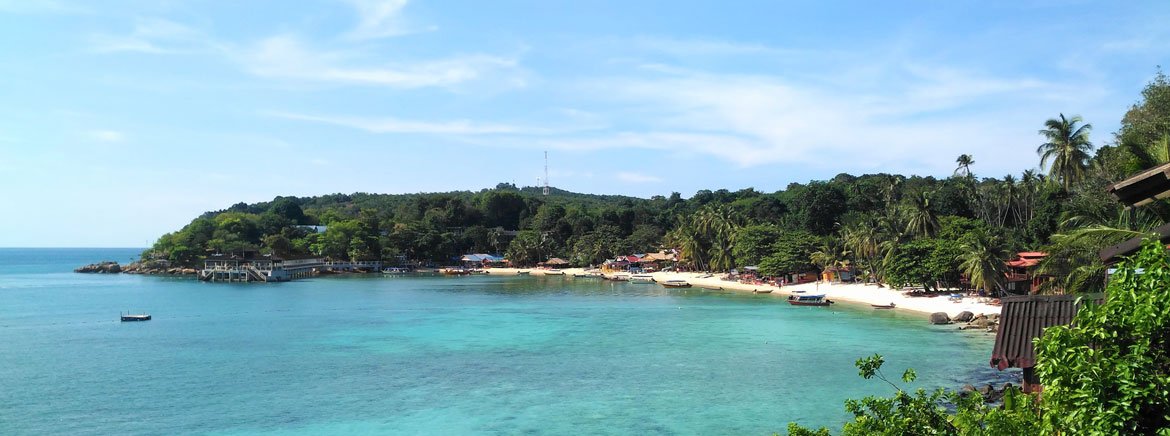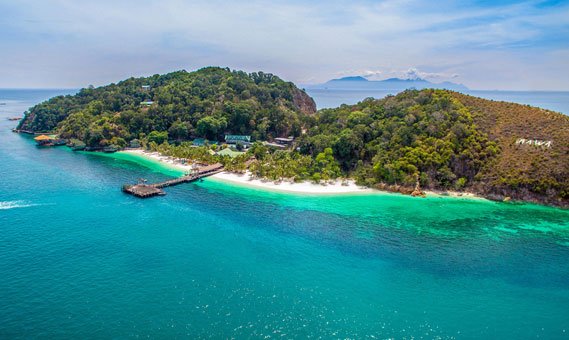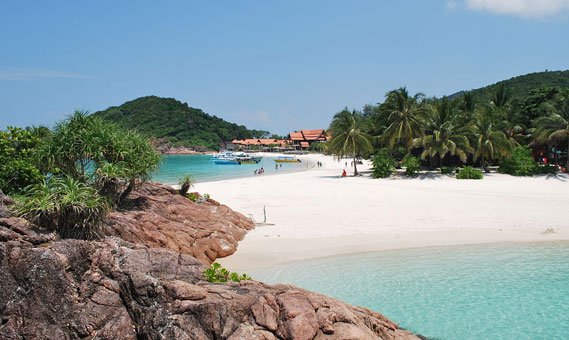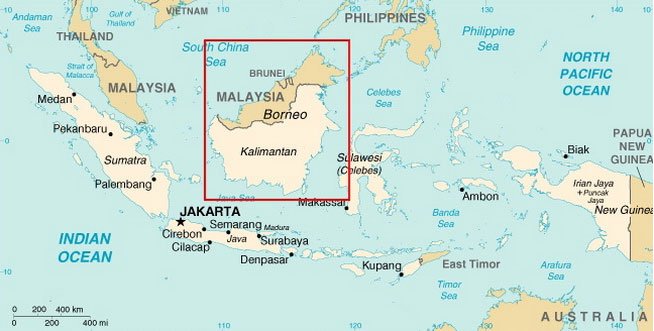
MALAYSIA – EAST COAST ISLANDS
Take a look at our Itineraries: The Langkawi : Langkawi to Phuket : Malaysian East Coast Islands
The Malaysian Peninsular has two distinct weather patterns caused by the two monsoons, while the Islands on the West Coast such as Langkawi are experiencing their wet season between May and October the islands on the East coast are having their finest months.
The seas are calm and with little rain these months are ideal for cruising this coastline and exploring the many islands on Schooner Dallinghoo. These island are renowned for their powder white sandy beaches, crystal clear aqua blue water and lush green jungle interiors making these an amazing cruise opportunity.
Though there are islands along most of the east coast they can be mostly be split into two groups, the Seribuat Archipelago in the south and the northern islands off Terengganu. Both these groups have a principle island, Pulau Redang in the north and Pulau Tioman in the south, these have fairly good connections by ferry and have airstrips. Due to these connections Redang is easily reached from both the major Malaysian cities of Penang and Kulua Lumpur and Tioman is reached easily from both Kuala Lumpur and Singapore. Due to this both have a number of resorts, basic infrastructure and can be a little busy especially at the weekend.
Lying off these two islands is a collection of smaller island, all beautiful and less explored many of which do not have ferry access and an only be accessed by private boats or yachts.
The Seribuat Archipelago, off the east coast of Johor, is a constellation of some of Malaysia’s most beautiful islands many regularly appear in magazines top  10 beaches / island in the world! Of the cluster of 64 islands, most people only know of Pulau Tioman, the largest, which is actually a part of Pahang. This leaves the rest of the archipelago as far less-visited dots of tranquility.
10 beaches / island in the world! Of the cluster of 64 islands, most people only know of Pulau Tioman, the largest, which is actually a part of Pahang. This leaves the rest of the archipelago as far less-visited dots of tranquility.
Pulau Tioman is in Pahang (“East Coast”) within the Mersing Marine Park, and consists of 13 islands including; Pulau Sibu, Pulau Harimau, Palau Mensirip, Pulau Goal, Pulau Besar, Pulau Tengah, Pulau Hujong, Pulau Rawa, Pulau Tinggi, Pulau Mentinggi, Pulau Sibu Hujung, Pulau Pemanggil and Pulau Aur.
Tioman’s beaches were depicted in the 1958 movie South Pacific as “Bali Hai”. In the 1970s, Time magazine selected Tioman as one of the world’s most beautiful islands. The densely forested island is still sparsely inhabited. Also it is surrounded by numerous white coral reefs, making it a haven for scuba divers from around the region.
Tioman is a popular tourist spot easily accessible by plane from KL and Singapore. It doesn’t as many white coral sand beaches, but the sea is crystal clear and there are many diving sites around the island. Tioman is quite big (20 Km from north to south) and is covered by tropical rainforest. There are many jungle trails and one of them connects the main village on the west coast with Juara beach on the east coast, the densely forested island is still sparsely inhabited with a couple of small villages and a number of resorts. With both a marina and airstrip island is the main hub for travelers to the other less developed islands.
 Pulau Rawa has one resort and a dream of a beach – beautiful, with white coral sand, coconut trees and crystal clear water. The resort consists of a large number of and there is just this one beach, which is not too long, perhaps 200m. The rest of Pulau Rawa is inaccessible: dense rainforest, almost vertical walls of rock plunging into the sea.
Pulau Rawa has one resort and a dream of a beach – beautiful, with white coral sand, coconut trees and crystal clear water. The resort consists of a large number of and there is just this one beach, which is not too long, perhaps 200m. The rest of Pulau Rawa is inaccessible: dense rainforest, almost vertical walls of rock plunging into the sea.
Pulau Hujong is covered with dense forest. It has a longish beach on its west side with some buildings on it but no jetty. Near Hujong lies the Pulau Tengah island. This has several beaches, one with some buildings. Further to the north lies the island of Pulau Gual. It is uninhabited, has no jetty, almost no trees and just one short beach. North of Gual, a short distance by boat, lies the island of Pulau Mensirip. Mensirip is densely forested and has a long white coral sand beach on the south side. There is no accomodation whatsoever on Mensirip and no jetty. Pulau Harimau is the northernmost of this grouplet of islands and is quite close to Mensirip. Harimau is uninhabited, has almost no trees and just one beach on the south side. On its highest point there is an observation platform and a radio beacon accessible via a staircase.
Pulau Sibu, is the most southernly island in the archipelago and th island nearest to Singapore, like all the islands it has amazing natural beauty but is also renowned for it’s scuba diving and snorkeling as the whole area was turned into a Marine Park in 1993. The are no roads on Sibu. The island does have one motorbike in the kampong (village). The easiest way to travel around the island is by boat or on foot. The lack of roads has kept this island less commercial than some others in the region.
 Pulau Redang is famous for its crystal clear waters, white sandy beaches, and the tropical fish that inhabit the numerous reefs, many within 50 feet of the shore. It is set in the Redang Marine Park (Taman Laut Pulau Redang) which covers all 9 islands in the Redang Archipelago.
Pulau Redang is famous for its crystal clear waters, white sandy beaches, and the tropical fish that inhabit the numerous reefs, many within 50 feet of the shore. It is set in the Redang Marine Park (Taman Laut Pulau Redang) which covers all 9 islands in the Redang Archipelago.
Redang has beautiful beaches, crystal clear waters and offers plenty of diving opportunities. The island is more developed and more upmarket then Perhentian island, which lies some 70 Km to the north which is more for budget conscious travelers. Redang has a more upmarket image, as almost all accommodation on the island is resort-based. The largest beach is Pasir Panjang on the east side, featuring half a dozen resorts. Great snorkeling is also found to the north of Pasir Panjang.
Pulau Lang Tengah is a small island lying between the Perhentian and Redang islands, about 20km off the east coast Malaysia. Lang Tengah has beautiful beaches and is surrounded by crystal clear water. The beaches are all on the southwestern side of the island. Lang Tengah is covered by rainforest and the maximum elevation is approx. 100m. A small path connects the beaches with the northeastern side of the island. Accommodation on the island consists of a few resorts, among which the Sari Pacifica is currently the most luxurious one.
 The Perhentian Islands (pronounced Perhen-TEE-AHN, not Perhen-SHEN) lie approximately 10 nautical miles (19 km) off the coast of northeastern Malaysia in the state of Terengganu, approximately 40 miles (64 km) south of the Thai border. The name Perhentian means “stopping point” in Malay. This is because the islands became a staging point used by traders traveling from Malaysia to Bangkok. Perhentian is one of the most beautiful of Malaysia’s islands, if not the most beautiful. Head here if you are looking for crystal clear waters and palm-fringed white coral sand beaches. Perhentian is less developed than nearby Redang island and sports a kind of unique wild beauty.
The Perhentian Islands (pronounced Perhen-TEE-AHN, not Perhen-SHEN) lie approximately 10 nautical miles (19 km) off the coast of northeastern Malaysia in the state of Terengganu, approximately 40 miles (64 km) south of the Thai border. The name Perhentian means “stopping point” in Malay. This is because the islands became a staging point used by traders traveling from Malaysia to Bangkok. Perhentian is one of the most beautiful of Malaysia’s islands, if not the most beautiful. Head here if you are looking for crystal clear waters and palm-fringed white coral sand beaches. Perhentian is less developed than nearby Redang island and sports a kind of unique wild beauty.
The small, uninhabited islands of Susu Dara, Seringgi and Rawa lie off Kecil. All the islands belong to a protected marine park, which means that fishing, collecting coral and littering are strictly prohibited, although in practice litter is one of the major problems that face the islands.
GETTING THERE
Joining Schooner Dallinghoo for a Borneo adventure would mean flying in to either KK or Labuan though it is also possible to join in Brunei.

Pulau Redang
During the high season May to October regular flights are available direct to Redang. Redang Airport is a small airport with services operated by Berjaya Air from Singapore (Changi Airport) and Kuala Lumpur (Sultan Abdul Aziz Shah Airport).
You can also fly to Kuala Terengganu’s airport called Sultan Mahmud Airport (IATA: TGG, ICAO: WMKN) serving domestic and international routes is located 8 km (5.0 mi) from the city centre, in Seberang Takir, Kuala Nerus. The airlines serving this airport are Malaysia Airlines, Firefly, AirAsia, Malindo Air, and Sriwijya Air. If flying in to Terengganu you will need to catch the ferry services to Pulau Redang, these services are mainly carried out by modern express ferries. The ferries dock at Syahbandar Jetty, just in front of the General Post Office. It is also possible to arrange private ‘resort’ boats to taxi you across to Redang. Kuala Terengganu can also be reach by road and there are regular bus services from Malaysia Capital Kualala Lumpur, then as with flying Redang is only a short boat ride away.

Pulau Tioman
Tioman Airport (IATA: TOD, ICAO: WMBT), also known as Pulau Tioman Airport, it is located next to Tekek village (Kampung Tekek). The main village on the island and is also the location of the marnina and ferry port. Flights are by propeller plane service by Berjaya Air from the Changi Airport in Singapore and Sultan Abdul Aziz Shah Airport in Kuala Lumpur.
Tioman island is served by ferries from the Malaysian mainland from the town of Mersing where there are good road links to both Singapore and Kuala Lumpur. Mersing port in the mouth of Mersing River is the main port for ferries to Pulau Tioman and the more than 40 other islands in the Seribuat Archipelago. Mersing town lies on the main trunk road that connects south to Singapore as well as west to Kuala Lumpur
MALAYSIA – LANGKAWI
During the ‘winter’ months from November to May while the islands off the East Coast are experience their monsoon season the west coast of Malaysia are enjoying their high season with perfect weather. Langkawi is the ‘Jewel of Kedah’ and a shining light of Malaysian tourism though the tourism here is low key compared the mass tourism north on the Thai island of Phuket and on Langkawi there are never any crowds and the pass of life is relaxed.
Langkawi is the main island of an archipelago of 99 islands and only one of two which are inhabited, it has a mountain range in the north running down to the plains in the centre with the rice paddies and then the main city of Kuah in the south. There are numerous islands and bays offering safe anchorages and the islands can be sailed all year round and in any weather conditions. The northern beaches and bays are among the finest in the world. Langkawi is a gorgeous cruising area, featuring high cliffs and hundreds of potential excursions. Swim in a freshwater lake, or visit the wildlife sanctuary to see sea eagles and monkeys.
The islands were given a World Geopark status by Unesco in 2007. The main conservation areas are Machincang Cambrian Geoforest Park, Dayang Bunting Marble Geoforest Park and last but not least Kilim Karst Geoforest park. These areas are the most popular areas for tourists, and due to their protected nature are something you don’t want to miss.
The islands of Langkawi will serve as your gateway to unspoiled paradise and an unforgettable sailing adventure. Dallinghoo will be moored in the Talaga Harbour only a 10 minutes from the airport, guests will be met and brought to the yacht – from here your adventure starts!
Ashore there are numerous activities and attractions a few not to be missed are;- Underwater World, The Langkawi cable car will take you up to the top of Gunung Mat Chinchang, and here you can find a second wonder – the Langkawi sky bridge! There are many artistic and cultural delights throughout the island plus an array of 5* hotels and restaurants many on the water’s edge and Dallinghoo can anchor just off shore. Whether it be shopping in one of the many malls, markets or fairs, sitting on the beach, exploring caves and mangroves, bird-watching, or hiking Langkawi and the islands have a lot to offer and there is no better way of seeing it than on board Dallinghoo.
Getting there
Langkawi is easy to reach and with a number of options, there is the International airport serviced by a number of regional hubs and with numerous flights a day from Kuala Lumpur, Malaysia’s capital and Penang Malaysia’s 2nd city. Kuah has a major ferry terminal with ferries running throughout the day to the Malaysian mainland ports of Peris and Kuala Kedah along with ferries to the island of Penang to the south and Satun in Southern Thailand to the north.
Generally with guests flying in Dallinghoo would be waiting in Talaga Harbour close by the airport however if guest come over to the islands by ferry we will be anchored in the Kuah Harbour ready to guests straight from the ferry.
